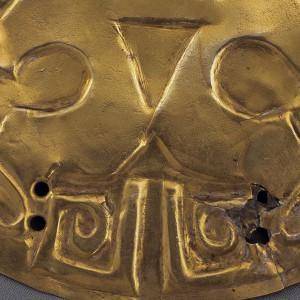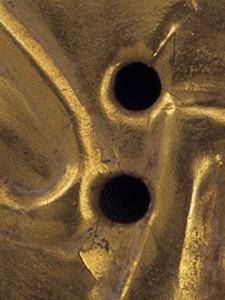Breastplate with Supernatural Crocodile
Although we don’t know who created this piece, we do know about the artist’s process. This plaque was made out of a gold and copper alloy, or metallic mixture. Mixing gold with copper lends strength to the piece, but the artist would have been careful not to add too much copper because it can lead to corrosion. The artist first heated the gold alloy and then hammered it using a stone tool, repeating the process until the desired thickness was achieved. He then cut out a circular disc and embossed the design onto the surface, adding additional detailing with a chisel. To emboss the design, the artist laid the disc on a firm but somewhat yielding surface and pushed the metal out from the back.
This gold plaque was reportedly found at Parita, on the Azuero Peninsula of central Panama. It closely resembles breast ornaments found in graves at Sitio Conte, an archaeological site in central Panama. In addition to gold plaques such as this, the most powerful and important individuals buried at the site were surrounded with extraordinarily lavish offerings, including sacrificed attendants, polychrome pottery, whale and shark teeth, and other gold ornaments.
Plaques like this, sometimes stacked on top of one another, have been found covering the chests of high status individuals in archaeological excavations of tombs. Hammered into this flat, gold plaque is a figure in an upright human-like pose. This creature has sometimes been called the “Crocodile God.” It has long, reptilian claws, a split tail, staring eyes, flaring nostrils, and a wide mouth with sharp, interlocking teeth. The ears are pointed and horn-like elements rise from the head. Above the head are two fish-like animals with spiky bodies. Powerful individuals in ancient society probably identified themselves with this fierce looking supernatural being. Recent research suggests that the figure may represent an iguana with supernatural attributes.
Details

Head
The large rectangular head has a mask-like face with circular eyes and a flattened nose. The grinning or grimacing mouth has prominent triangular interlocking teeth. On the side of the head are upward-flowing ear ornaments. Antler-like appendages protrude from the top of the head. Two sharks are entwined in the antler projections on either side of the head.

Body
The body is androgynous and unclothed. Both the hands and feet have claws, five on the hands and four on the feet.

Tail
At the bottom of the figure is a split, curved tail that spirals outward in opposite directions. In the center of the figure is a triangular depression.

Holes
Four pairs of holes were pierced through the finished disk so that it could be held firmly in place on the clothing or costume.
More Resources
Books
Helms, Mary W. Ancient Panama: Chiefs in Search of Power. Austin: University of Texas Press, 1979.
An exploration of the political and religious elite of ancient Panama.
Hearne, Pamela, and Robert J. Sharer, eds. River of Gold: Pre-Columbian Treasures from Sitio Conte. Philadelphia: University Museum, University of Pennsylvania, 1992.
A discussion of the motifs and techniques used in the gold work of Panama, as well as several images of other golden disk reliefs.
Kubler, George. The Art and Architecture of Ancient America. New Haven: Yale University Press, 1993.
A short description of the artistic styles of Panama, pp. 339-340.
Sanchez, Margaret Young. Pre-Columbian Art in the Denver Art Museum Collection. Denver, CO: Denver Art Museum, 2003.
A museum publication which explores other Pre-Columbian artworks in the DAM collection.
Townsend, Richard F. The Ancient Americas: Art from Sacred Landscapes. Chicago and Munich: The Art Institute of Chicago and Prestel Verlag, 1992.
The article in this book by Mary W. Helms, entitled “Cosmovision of the Chiefdoms of the Isthmus of Panama,” describes the social importance of Panamanian art and what it can tell us about their life and cosmology.
Funding for object education resources provided by a grant from the Morgridge Family Foundation. Additional funding provided by the William Randolph Hearst Endowment for Education Programs, and Xcel Energy Foundation. We thank our colleagues at the University of Denver Morgridge College of Education.
The images on this page are intended for classroom use only and may not be reproduced for other reasons without the permission of the Denver Art Museum. This object may not currently be on display at the museum.
